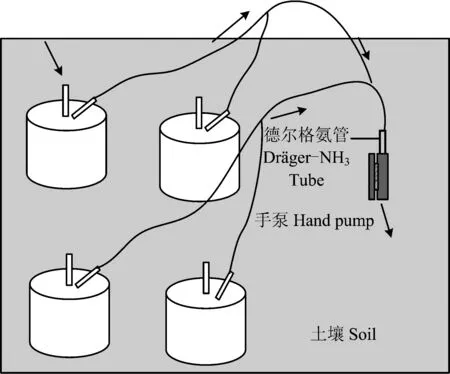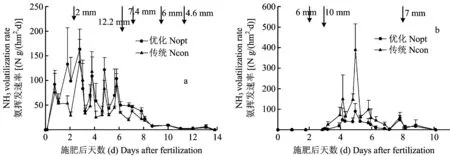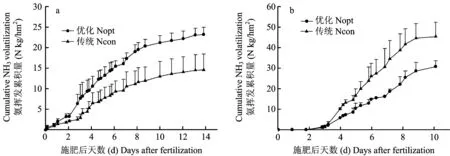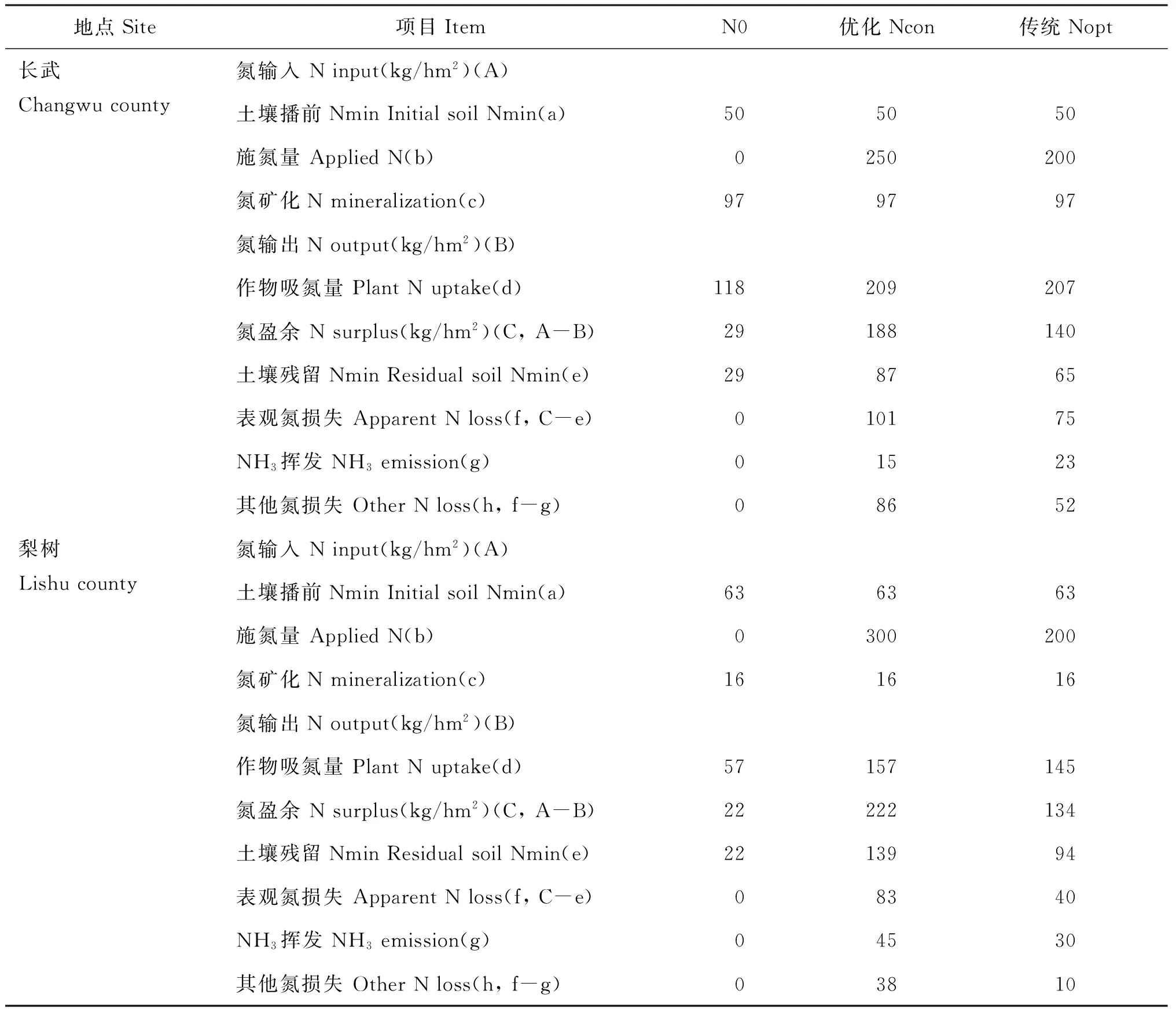传统和优化施氮对春玉米产量、氨挥发及氮平衡的影响
2015-06-15李欠欠李雨繁李世清陈新平张福锁刘学军
李欠欠, 李雨繁, 高 强, 李世清, 陈新平, 张福锁, 刘学军*
(1 中国农业大学资源与环境学院,北京 100193; 2 吉林农业大学资源与环境学院,吉林长春 130118;3 西北农林科技大学水土保持研究所,陕西杨凌 712100)
传统和优化施氮对春玉米产量、氨挥发及氮平衡的影响
李欠欠1, 李雨繁2, 高 强2, 李世清3, 陈新平1, 张福锁1, 刘学军1*
(1 中国农业大学资源与环境学院,北京 100193; 2 吉林农业大学资源与环境学院,吉林长春 130118;3 西北农林科技大学水土保持研究所,陕西杨凌 712100)

春玉米; 产量; 氮肥利用率;氨挥发; 氮平衡
我国氮肥用量占全球氮肥用量的30%左右[1]。氮肥施入农田土壤后,作物吸收利用率普遍低于50%,大部分损失于环境中,氨挥发是氮肥损失的重要途径之一[2-3]。进入到大气中的氨可以沉降方式返回陆地、海洋生态系统[4],过量的氨沉降可引起生态系统酸化、富营养化、降低生物多样性等一系列问题; 同时,氨作为空气中二次颗粒物(如PM2.5)来源的重要组成部分,与人体呼吸系统健康也有密切联系[5-6]。玉米作为我国的三大粮食作物之一,其种植区域主要分布于我国华北、东北以及西北。目前针对玉米体系的田间氨挥发损失已有研究,但主要集中于华北平原[7-10]。针对东北及西北的春玉米体系氨挥发损失研究很少[11-12],还需进一步系统研究。此外,由于技术及多处理试验小区面积等限制,微气象方法(如梯度扩散法、质量平衡法)对土壤氨挥发测定在我国进行较少[13]。目前国内许多氨挥发研究采用的是简易密闭箱式法[12]、海绵通气法[14]等,虽然满足了小尺度多处理田块上氨挥发监测,但由于无法考虑自然条件下的风速等气象条件,通常与氨挥发的实际排放量有一定差异。为此,本研究参考Pacholski等的研究[15-17],结合自然条件下的风速等气象条件,采用校正的德尔格氨管法(简称DTM法)对东北、西北春玉米季的田间氨挥发开展原位测定,评价春玉米体系的土壤氨挥发通量。此外,通过比较传统和优化施氮条件下土壤氨挥发通量、春玉米产量以及土壤-春玉米作物系统氮素表观平衡,以期为春玉米体系氮素优化管理、减少氮素损失及提高氮肥利用率等提供科学依据。
1 材料与方法
1.1 试验点概况
春玉米田间试验于2011年分别设在两个典型的北方春玉米种植区域,为西北的陕西省长武县(CW)和东北的吉林省梨树县(LS)。长武县位于黄土高原渭北旱塬,35°12′N,107°47′E,海拔1184 m,属暖温带半湿润易旱气候区,年均气温9.1℃,无霜期171 d,土壤类型为黑垆土,2011年春玉米生育期间的降水量为500 mm;东北的吉林省梨树县,地处43°18′N,124°20′E,海拔155 m,属寒温带半湿润大陆性气候区,年均气温5.8℃,无霜期140 d,土壤类型为黑土,2011年春玉米生育期间的平均降水量为340 mm。两试验区的土壤基本理化性状见表1。

表1 供试土壤(0—20cm)基本理化性状
1.2 试验设计
两试验点均设3个施氮处理,为不施氮对照,传统施氮(施氮量长武点为N 250 kg/hm2,梨树点为N 300 kg/hm2)和优化施氮(两点均为N 200 kg/hm2),分别以N0、Ncon、Nopt表示。每处理3次重复,小区面积为40 m2,田间完全随机排列。两试验点具体施肥的方法和时间见表2。所有处理磷肥和钾肥施用量相同,均为P2O560 kg/hm2、钾肥K2O 60 kg/hm2,在播种时作基肥一次施入。此外,依照长武当地的管理方式,所有处理均采用半膜覆盖技术,长武点春玉米种植密度为75000 plant/hm2。梨树点春玉米种植密度为60000 plant/hm2。
玉米品种均为先玉335,春玉米生长季无灌溉,除草、病虫害防治等田间管理也均采用当地的传统方式进行。

表2 试验期间长武、梨树点的施肥量与施肥时间
注(Note): 除梨树点播种期氮肥采用15-15-15氮磷钾复合肥外,其他氮肥均采用尿素Except seeding time’s N application at LS site conducted as NPK(15-15-15) compound fertilizer, and all the other treatments conducted as urea.
1.3 德尔格氨管法(DTM)氨挥发的原位测定方法

图1 测定氨挥发的DTM试验装置示意图Fig.1 Experimental set-up of DTM for ammonia volatilization

1.4 氨挥发的计算方法
DTM氨挥发原位测定计算公式为
FNg=V·∣conc.∣·10-6·pNH3·UN·UF·UZ
式中: FNg为氨排放量[N mg/(m2·h)];V为抽气的体积(L);∣conc.∣为氨气的浓度(μl/L);pNH3为该温度气压下NH3密度(mg/L);UN为NH3换算为N的分子量换算因子;UF为表面积换算因子(m2);UZ为时间换算因子(h)。
经过为气象学方法校正的DTM氨挥发的计算方法为:
冬季 ln(NH3fluxIHF)=0.444·ln(NH3fluxDTM)+0.590·ln(V2m)
夏季 ln(NH3fluxIHF)=0.456·ln(NH3fluxDTM)+0.745·ln(V2m)-0.280·ln(V0.2m)
式中: NH3fluxIHF表示由IHF微气象法测定的氨挥发量[N kg/(hm2·h)];V2m与V0.2m分别表示距地面2 m与0.2 m的风速(m/s);NH3fluxDTM表示 DTM测定的氨挥发量[N kg/(hm2·h)]。
通过DTM进行原位测定,结合气象数据(以风速为主),校正为微气象学(IHF)下的氨挥发通量。由于该监测方法已和IHF微气象学法进行了校验,所得结果接近于IHF法,而且具有操作简便的特点,无需将氨采集后再进行实验室分析。 因此该方法在进行多个处理的田间氨挥发测定中具有明显的优势。有关此DTM法的详细介绍可参考文献[13,15-17]。

2 结果与分析
2.1 春玉米产量、吸氮量及氮肥利用率

2.2 春玉米生长季氨挥发的动态变化及累积量



表3 不同施肥处理下长武和梨树点春玉米产量、吸氮量和氮素利用率
注(Note): 籽粒产量是指包括14%含水量的玉米产量,地上生物量是指籽粒、棒芯和秸秆的干物质总量The grain yield denotes air dry grain yield with 14% moisture and the shoot biomass refers to total dry matter yield of grain, cobs and straw . 氮素利用率(ANR%)=(施肥区氮吸收-对照区氮吸收)/氮肥施用量×100, ANR% =(N uptake in fertilized treatment-N uptake in unfertilized treatment)/N applied in fertilized treatment×100. 同列数据后不同字母表示处理间差异达5%显著水平 Values followed by different letters in a column are significant among treatments at the 5% level.

图2 追肥期长武(a)和梨树(b)春玉米田间氨挥发动态Fig.2 Rate of NH3 losses in Changwu county(a) and Lishu county(b) spring maize field with top-dressing fertilization[注(Note): 箭头表示降雨Arrows denote rainfall events.]

图3 追肥期长武(a)和梨树(b)春玉米田间氨挥发累积量Fig.3 Cumulative NH3 losses at Changwu county(a) and Lishu county(b) sites during N top-dressing of spring maize

2.3 春玉米生长季的氮素平衡

3 讨论与结论
3.1 氮肥的玉米产量效应与节氮潜力

3.2 玉米季的氮肥氨挥发损失特征


表4 不同施肥处理下长武和梨树春玉米田间氮的表观平衡
注(Note): 氮矿化=(对照区吸氮量-播前对照区0—1 m土壤无机氮量+收获后对照区0—1 m土壤无机氮残留量) N mineralization= N uptake from control-initial 0-1 m soil Nmin in the control + residual 0-1 m soil Nmin in the control


3.3 氮素优化对土壤-玉米体系氮素平衡的影响


[1] 中国农业年鉴编辑委员会. 中国农业年鉴[M]. 北京: 中国农业出版社, 2004. Editorial Committee of China Agricultural Yearbook. China agricultural yearbook [M]. Beijing: China Agricultural Press, 2004.
[2] 朱兆良. 农田中氮肥的损失与对策[J]. 土壤与环境, 2000, 9(1): 1-6. Zhu Z L. Loss of fertilizer N from plants-soil system and the strategies and techniques for its reduction[J]. Soil and Environmental Sciences, 2000, 9(1): 1-6.
[3] Cui S H, Shi Y A, Groffman P Metal. Centennial-scale analysis of the creation and fate of reactive nitrogen in China(1910-2010)[J]. Proceedings of the National Academy of Sciences of the United States of America, 2013,110: 2052-2057.
[4] Galloway J N, Townsend A R, Erisman J Wetal. Transformation of the nitrogen cycle: Recent trends, questions, and potential solutions[J]. Science, 2008, 320: 888-892.
[5] Liu X J, Duan L, Mo J Metal. Nitrogen deposition and its ecological impact in China: An overview[J]. Environmental Pollution, 2011, 159: 2251-2264.
[6] Sutton M A, Oenema O, Erisman J Wetal. Too much of a good thing[J]. Nature, 2011, 472: 159-161
[7] 李宗新, 董树亭, 王空军, 等. 不同肥料运筹对夏玉米田间土壤氮素淋溶与氨挥发影响的原位研究[J]. 植物营养与肥料学报, 2007, 13(6): 998-1005. Li Z X, Dong S T, Wang K Jetal. In situ study on influence of different fertilization strategies for summer maize on soil nitrogen leaching and volatilization[J]. Plant Nutrition and Fertilizer Science, 2007, 13(6): 998-1005.
[8] 李贵桐, 李保国, 陈德立. 大面积冬小麦夏玉米农田土壤的氨挥发[J]. 华北农学报, 2002,17(1): 76-81. Li G T, Li B G, Chen D L. Ammonia volatilization from large field planted with winter wheat and summer maize[J]. Acta Agriculturae Boreali-Sinica, 2002, 17(1): 76-81.
[9] 苏芳, 丁新泉, 高志岭, 等. 华北平原冬小麦-夏玉米轮作体系氮肥的氨挥发[J]. 中国环境科学, 2007, 27(3): 409-413. Su F, Ding X Q, Gao Z Letal. Ammonia volatilization from nitrogen fertilization of winter wheat-summer maize rotation system in the North China Plain[J]. China Environmental Science, 2007, 27(3): 409-413.
[10] 张玉铭, 胡春胜, 董文旭. 华北太行山前平原农田氨挥发损失[J]. 植物营养与肥料学报, 2005, 11(3): 417-419. Zhang Y M, Hu C S, Dong W X. Ammonia volatilization from wheat-maize rotation field in the piedmont of Taihang[J]. Plant Nutrition and Fertilizer Science, 2005, 11(3): 417-419.
[11] 纪玉刚, 孙静文, 周卫, 等. 东北黑土玉米单作体系氨挥发特征研究[J]. 植物营养与肥料学报, 2009, 15(5): 1044-1050. Ji Y G, Sun J W, Zhou Weietal. In situ study of ammonia volatilization from black soil with maize monoculture system[J]. Plant Nutrition and Fertilizer Science, 2009, 15(5): 1044-1050.
[12] 王连君, 刘中军, 王继红. 黒土玉米农田生态系统氮磷配施氨挥发规律[J]. 东北林业大学学报, 2009, 37(7): 87-90. Wang L J, Liu Z J, Wang J H. Ammonia volatilization of corn farm land ecosystem under various proportions of nitrogen and phosphorus in black soil[J]. Journal of Northeast Forestry University, 2009, 37(7): 87-90.
[13] Roelcke M, Li S X, Tian X Hetal. In situ comparisons of ammonia volatilization from N fertilizers in Chinese loess soils[J]. Nutrient Cycling in Agroecosystems, 2002, 62: 73-88.
[14] 王朝辉, 刘学军, 巨晓棠, 张福锁. 田间土壤氨挥发的原位测定-通气法[J]. 植物营养与肥料学报, 2002, 8(2): 205-209. Wang Z H, Liu X J, Ju X T, Zhang F S. Field in situ determination of ammonia volatilization from soil: Venting method[J]. Plant Nutrition and Fertilizer Science, 2002, 8(2): 205-209.
[15] Pacholski A, Cai G X, Fan X Hetal. Comparison of different methods for the measurement of ammonia volatilization after urea application in Henan Province, China[J]. Journal of Plant Nutrition and Soil Science, 2008, 171: 361-369.
[16] Pacholski A, Cai G X, Nieder Retal. Calibration of a simple method for determining ammonia volatilization in the field-comparative measurements in Henan Province, China[J]. Nutrient Cycling in Agroecosystems, 2006, 74: 259-273.
[17] Gericke D, Pacholski A, Kage H. Measurement of ammonia emissions in multi-plot field experiments[J]. Biosystems Engineering, 2011, 108: 164-173.
[18] Liu X J, Ju X T, Zhang F Setal. Nitrogen dynamics and budgets in a winter wheat-maize cropping system in the North China Plain[J]. Field Crops Research, 2003, 83: 111-124.
[19] Ju X T, Xing G X, Chen X Petal. Reducing environmental risk by improving N management in intensive Chinese agricultural systems[J]. Proceedings of the National Academy of Sciences of the United States of America, 2009, 106: 3041-3046.
[20] 李建奇. 地膜覆盖对春玉米产量、品质的影响机理研究[J]. 玉米科学, 2008, 16(5): 87-92, 97. Li J Q. The mechanism study of the influences of plastics film mulch on grain yield and seed quality of spring maize[J]. Journal of Maize Sciences, 2008, 16(5): 87-92, 97.
[21] 宋淑亚, 刘文兆, 王俊, 等. 覆盖方式对玉米农田土壤水分、作物产量及水分利用效率的影响[J]. 水土保持研究, 2012, 19(2): 210-217. Song S Y, Liu W Z, Wang Jetal. Effects of different mulching modes on soil moisture, grain yield and water use efficiency in a corn fields[J]. Research of Soil and Water Conservation, 2012, 19(2): 210-217.
[22] Sanz-Cobena A, Misselbrook T, Camp V, Vallejo A. Effect of water addition and the urease inhibitor NBPT on the abatement of ammonia emission from surface applied urea[J]. Atmospheric Environment, 2011, 45: 1517-1524.
[23] 高强, 蔡红光, 黄立华, 等. 吉林省半干旱地区春玉米连作体系氮素平衡研究[J]. 西北农林科技大学学报(自然科学版), 2009, 37(8): 127-132. Gao Q, Cai H G, Huang L Hetal. Study on soil nitrogen balance of spring maize continuous cropping in semi-arid area of Jilin Province[J]. Journal of Northwest A & F University(Natural Science Edition), 2009, 37(8): 127-132.
[24] 蔡红光, 米国华, 陈范骏, 等. 东北春玉米连作体系中土壤氮矿化、残留特征及氮素平衡[J]. 植物营养与肥料学报, 2010, 16(5): 1144-1152. Cai H G, Mi G H, Chen F Jetal. Characteristics of nitrogen mineralization and residual in the soil and nitrogen balance in the continuous spring maize cultivation system in Northeast China[J]. Plant Nutrition and Fertilizer Science, 2010, 16(5): 1144-1152.
Effect of conventional and optimized nitrogen fertilization on spring maize yield, ammonia volatilization and nitrogen balance in soil-maize system
LI Qian-qian1, LI Yu-fan2, GAO Qiang2, LI Shi-qing2, CHEN Xin-ping1, ZHANG Fu-suo1, LIU Xue-jun1*
(1CollegeofResourceandEnvironmentScience,ChinaAgriculturalUniversity,Beijing100193,China;2CollegeofResourceandEnvironmentScience,JilinAgriculturalUniversity,Changchun130118,China;3InstituteofSoilandWaterConservation,NorthwestA&FUniversity,Yangling712100,China))
【Objectives】 Two field experiments were conducted in spring maize at Changwu county(CW) of Shaanxi province and Lishu county(LS) of Jinlin province, to compare the effects of optimized and conventional N fertilization on crop yield, NH3volatilization, and N balance in soil-spring maize system. The objective of the paper was to quantify the N saving potential and NH3mitigation potential in spring maize under optimization N fertilization. 【Methods】 NH3volatilization was monitoredinsituwith a Dräger-Tube Method(DTM), which was corrected by a micrometeorological flux method in previous work. Three N treatments: CK(no N application), Ncon(conventional N fertilizer, N 250 kg/hm2at CW and N 300 kg/hm2at LS) and Nopt(optimized N fertilization, N 200 kg/hm2), were designed at the two sites. 【Results】 Except CK treatment(7.9 t/hm2at CW and 3.8 t/hm2at LS), no significant difference of maize yield between Ncon and Nopt was found at both sites(10.6-10.8 t/hm2at CW and 9.5-9.6 t/hm2at LS). In contrast, apparent N recovery was significantly higher in Nopt(44.3%-44.5%) than in Ncon(33.6%-36.4%). Compared with Ncon, apparent N recovery increased by 8.1 percentage points and 10.7 percentage points in Nopt at CW and LS, respectively. No obvious NH3loss was detected during the basal fertilization period with uniformly incorporated fertilizer into soil, combined with later precipitation at both sites. However substantial NH3volatilization, accounting for 16%-22% of N applied, was found at the two sites during N top-dressing period. Reduced N application of N 30 kg/hm2(CW) and N 100 kg/hm2(LS) could significantly reduce NH3volatilization(N 8 kg/hm2at CW and N 15 kg/hm2at LS). Calculated N balance results showed regional difference for N surplus and apparent N loss between CW and LS sites. For apparent N mineralization, N 97 kg/hm2was observed at CW site, while only N 16 kg/hm2at LS site. The Nopt significantly decreased N surplus N 48-88 kg/hm2compared with Ncon. At CW, about 46% of N surplus was as 0-1 m residual soil N, and 54% of N surplus lost to environment, and NH3volatilization accounted for 15%-30% of total N loss. At LS, about 65% N surplus existed as 0-1 m residual soil N, 35% of N surplus lost to environment, and NH3volatilization accounted for 54%-75% of total N loss. Nearly N 140 kg/hm2of residual soil N in Ncon treatment at LS, while parts of residual soil N may be lost due to N leaching and/or nitrification/denitrification. Compared with Ncon, the Nopt treatment significantly decreased N 30-40 kg/hm2of N loss. The N loss results also showed large amounts of N unaccounted for(other N loss) was not NH3loss but a considerable amount of N leaching, and/or denitrification. 【Conclusions】 Out results reveal that there is a N saving potential of N 50-100 kg/hm2or 20%-33% of conventional N rate in major spring maize production area of China without yield loss but significant less N loss to the environment.
spring maize; grain yield; N recovery; ammonia volatilization; apparent N balance
2014-02-17 接受日期: 2014-05-09
国家自然科学基金项目(41071151) 资助。
李欠欠 (1984—), 女, 江苏徐州人, 博士研究生, 主要从事植物营养与肥料方面的研究。E-mail: cute_lq@163.com * 通信作者 E-mail: liu310@cau.edu.cn
S513.062; S153.6+1
A
1008-505X(2015)03-0571-09
